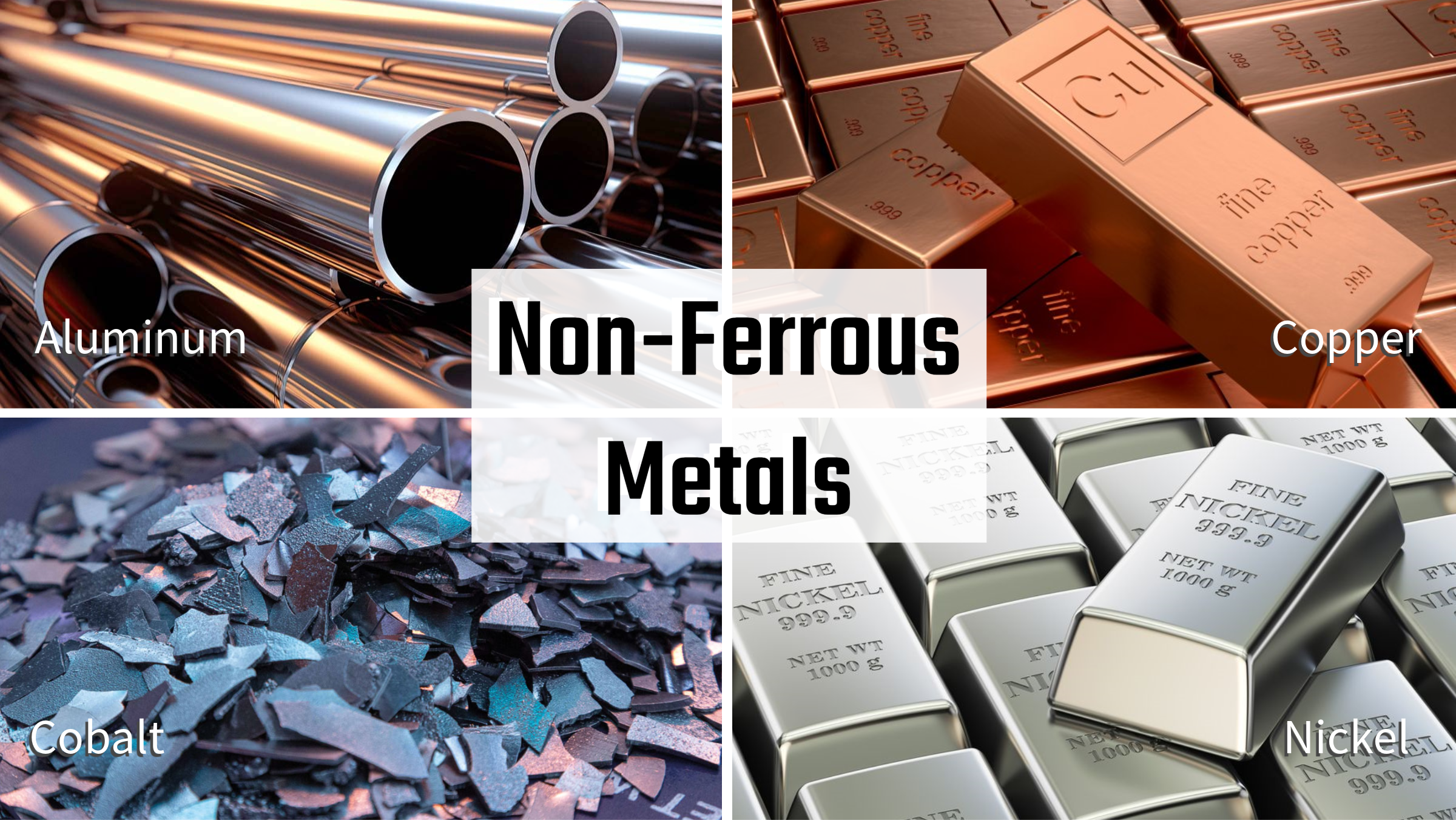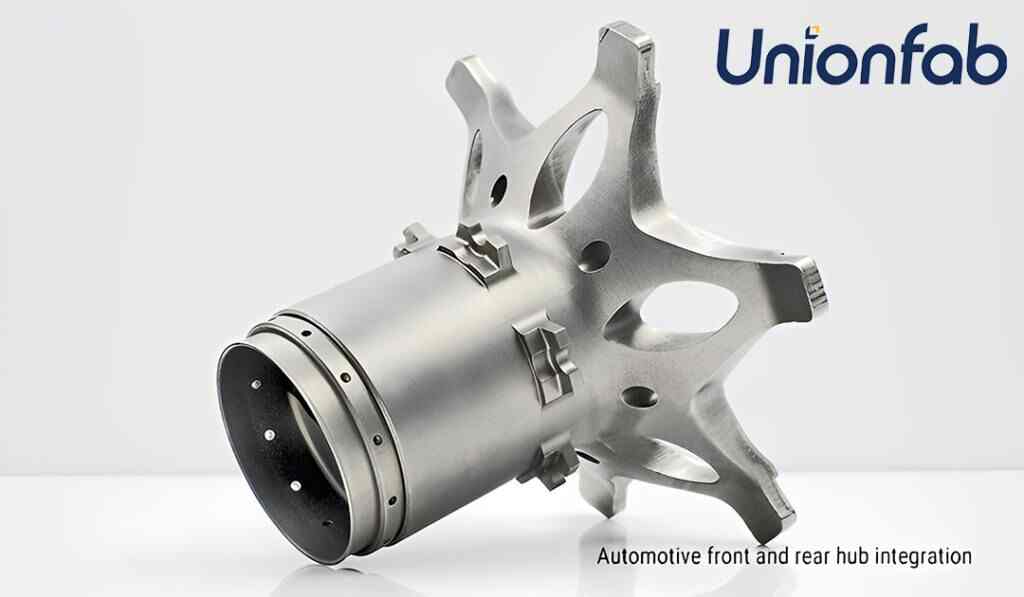Non-Ferrous Metals: A Comprehensive Guide

Understand non-ferrous metals’s significance, properties, and diverse applications across various industries with this comprehensive guide.
Introduction
Definition of Non-Ferrous Metals
Non-ferrous metals are metals that contain little to no iron in their composition. The key distinction is the iron content; by definition, non-ferrous metals have less than 1% iron by weight. This lack of iron gives them several key properties that differ from ferrous metals (metals with a high iron content, like steel). Most notably, non-ferrous metals are not magnetic.
Non-ferrous metals are vital for a wide range of industries due to their unique properties.
Types of Non-Ferrous Metals
Non-ferrous metals encompass a wide range, each with unique properties and applications. Here's a breakdown of some common and lesser-known examples:
Common Non-Ferrous Metals
Aluminum (Al): The most abundant metal on Earth (excluding iron). It's lightweight, malleable, ductile, and a good conductor of electricity and heat. Widely used in construction (siding, cans), transportation (car bodies), and consumer goods (cookware, foil).
Copper (Cu): An excellent conductor of electricity and heat, and highly resistant to corrosion. Essential for electrical wiring, power transmission lines, plumbing pipes, and heat sinks in electronics.
Lead (Pb): Historically a common metal, but its use is declining due to health concerns. Lead has good sound dampening properties and is still used in car batteries and some ammunition.
Zinc (Zn): Provides excellent corrosion protection to other metals when applied in a thin layer (galvanization). Also used in alloys like brass and in batteries.
Lesser-Known Non-Ferrous Metals
Titanium (Ti): Exceptionally strong and lightweight, with excellent corrosion resistance. Used in high-performance applications like aircraft parts, medical implants, and sporting goods.
Nickel (Ni): Often alloyed with other metals to improve strength and corrosion resistance. Found in stainless steel, rechargeable batteries, and some coins.
Tin (Sn): Primarily used as a protective coating on steel (tin cans) due to its corrosion resistance. Also used in solder for electronic components.
Cobalt (Co): A key component in lithium-ion batteries for electric vehicles and electronics. Cobalt also strengthens steel and is used in high-temperature alloys.
This list is not exhaustive, there are many other non-ferrous metals with specialized applications. Some metals, like nickel and cobalt, can be both common (in alloys) and lesser-known (in pure form).
Understanding Non-Ferrous Metals
Contrast with Ferrous Metals
The primary difference between ferrous and non-ferrous metals lies in their iron content. Ferrous metals, like steel, contain a significant amount of iron (usually making up the largest portion) which gives them specific properties. Here's a table summarizing the key contrasts:
Property | Ferrous Metals | Non-Ferrous Metals |
|---|---|---|
Iron Content | High (Main component) | Low (Less than 1% by weight) |
Magnetic Properties | Magnetic | Non-Magnetic |
Corrosion Resistance | Generally lower, prone to rust | Generally higher, resist corrosion better |
Malleability & Ductility | Can be malleable and ductile, but to a lesser extent | Often more malleable and ductile, easier to shape |
Conductivity | Generally lower electrical and thermal conductivity | Can have high electrical and thermal conductivity depending on the metal |
Properties Distinguishing Non-Ferrous Metals
Non-ferrous metals offer a variety of properties that make them valuable for specific applications. Here's a closer look at some key ones:
Corrosion Resistance: Unlike iron which readily reacts with oxygen to form rust, many non-ferrous metals form a thin oxide layer on their surface that protects them from further corrosion. This makes them ideal for applications exposed to moisture, weather, or harsh chemicals. Examples include copper pipes and aluminum building materials.
Lightweight: Some non-ferrous metals, particularly aluminum and titanium, have a high strength-to-weight ratio. This means they are strong yet significantly lighter than steel. This property is crucial in industries like aerospace and transportation where weight reduction is essential for fuel efficiency and performance.
Conductivity: Certain non-ferrous metals, especially copper and aluminum, excel at conducting electricity and heat. This makes them the preferred choice for electrical wiring, power grids, heat exchangers, and electronic components.
Non-Magnetic Properties: Since they lack iron, non-ferrous metals are not attracted to magnets. This property is valuable for applications requiring non-magnetic materials, such as medical equipment (MRI machines) and electrical components that might be affected by stray magnetic fields.
Non-Ferrous Materials: Beyond Metals
While non-ferrous typically refers to metals, the term can extend beyond just metals to encompass a broader range of materials that lack significant iron content and offer valuable properties for various technological advancements.
Alloys: These are mixtures of two or more elements, where at least one is a metal. Many non-ferrous metals are used to create alloys with specific properties. For example, combining copper and zinc creates brass, which is stronger and more corrosion-resistant than pure copper. Alloys can be non-ferrous even if they contain some iron, as long as the iron content remains below 1%.
Composites: These combine two or more distinct materials with different properties to create a material with superior overall performance. Non-ferrous metals can be part of composites. For instance, carbon fiber composites, used in aircraft construction, often incorporate aluminum or titanium for strength and rigidity.
Semiconductors: These are crucial materials in electronics. They can conduct electricity under certain conditions, making them ideal for transistors, integrated circuits, and other electronic components. Silicon is the most common semiconductor, but some non-metals like germanium and gallium can also be used.
Superconductors: These are a special class of materials that offer zero electrical resistance at very low temperatures. This allows for a perfect flow of electricity without any energy loss. While some superconductors are alloys (like niobium-titanium), others are non-metals like certain ceramics. Superconductors have various applications in areas like medical imaging (MRI machines) and high-speed maglev trains.
Non-Ferrous Alloys
Definition and Significance
Non-ferrous alloys are metallic mixtures where at least one main component is a non-ferrous metal (containing less than 1% iron) and other elements are added to achieve specific properties. These alloys are crucial in modern technology because they allow us to tailor the properties of a base metal to meet specific needs.
Here's why non-ferrous alloys are significant:
Enhanced Properties: By combining different elements, we can improve the strength, corrosion resistance, electrical conductivity, or other properties of the base metal. For example, adding copper to aluminum increases its strength for use in aircraft parts.
Versatility: Non-ferrous alloys offer a wider range of properties compared to pure metals. This allows engineers to select the most suitable material for a particular application.
Cost-Effectiveness: In some cases, using a non-ferrous alloy can be more cost-effective than using a pure rare metal. For instance, some titanium alloys offer similar strength-to-weight ratios as pure titanium at a lower price.
Common Non-Ferrous Alloy Compositions
Aluminum Alloys: Aluminum is the most abundant metal, but pure aluminum is relatively soft. Alloying it with elements like copper, magnesium, or silicon significantly improves its strength, making it suitable for various applications. Examples include:
Al-Cu (Duralumin): Used in aircraft structures due to its high strength-to-weight ratio.
Al-Mg (Magnallium): Lightweight and corrosion-resistant, used in beverage cans and building materials.
Copper Alloys: Copper is a great conductor, but it can be soft. Alloying it with other elements like zinc, tin, or nickel enhances its strength and other properties. Some common copper alloys include:
Cu-Zn (Brass): Stronger and more corrosion-resistant than copper, used for plumbing fixtures, doorknobs, and musical instruments.
Cu-Sn (Bronze): Strong, wear-resistant, and good for casting, used in statues, bearings, and electrical connectors.
Titanium Alloys: Pure titanium is strong and lightweight, but expensive. Alloying it with aluminum, vanadium, or molybdenum can improve its workability or high-temperature performance. These alloys are used in:
Ti-Al (Aerospace grade): High strength-to-weight ratio, ideal for aircraft parts.
Ti-6Al-4V (General purpose): Good balance of strength, ductility, and corrosion resistance, used in medical implants and sporting goods.
Zinc Alloys: Zinc is a good corrosion protectant for other metals, but it's brittle on its own. Alloying it with aluminum, copper, or magnesium improves its strength and casting properties. Zinc alloys are used in:
Zn-Al (ZAamak): Die-cast parts for cars and appliances due to its good casting properties and dimensional stability.
Zn-Cu (Brass): As mentioned earlier, brass is a copper alloy that often contains some zinc for added strength and machinability.
Future Prospects and Challenges
The future of non-ferrous metals looks promising, driven by advancements in material science, a growing focus on sustainability, and increasing demand in key sectors. However, there are also challenges to consider.
Advancements in Non-Ferrous Materials Research
Development of new alloys: Research is ongoing to create non-ferrous alloys with even better combinations of strength, weight, conductivity, and corrosion resistance. This could lead to lighter and more efficient vehicles, more powerful electronics, and longer-lasting infrastructure.
Additive manufacturing: 3D printing technologies are making it possible to create complex shapes with non-ferrous materials, enabling innovative designs and potentially reducing waste.
Nanotechnology: Research on manipulating materials at the nanoscale could lead to new non-ferrous metals with entirely new properties, opening doors for future advancements.
Sustainability and Recycling Initiatives
Increased recycling: Non-ferrous metals like aluminum and copper are highly recyclable, reducing the need for virgin material extraction and its environmental impact.
Development of more efficient recycling processes: New technologies aim to improve the efficiency and reduce the energy consumption of non-ferrous metal recycling, further enhancing its environmental benefits.
Focus on responsible sourcing: Growing awareness of the environmental and social impacts of mining is pushing for responsible sourcing practices to ensure ethical and sustainable mining of non-ferrous metals.
Challenges
Environmental impact of mining: Mining non-ferrous metals can still have environmental consequences like land disturbance and pollution. Minimizing this impact is essential.
Energy consumption of processing: Extracting and processing non-ferrous metals requires significant energy. Developing more energy-efficient methods is crucial for sustainability.
Geopolitical tensions affecting supply: Tensions between countries can disrupt the supply of certain non-ferrous metals, impacting prices and availability.
Conclusion
Non-ferrous metals have played a critical role in the development of modern civilization.
Unique Properties: Their lack of iron allows for a broad range of properties, including superior corrosion resistance, excellent conductivity, lightweight characteristics, and non-magnetic behavior. These properties make them irreplaceable in many applications.
Versatility: Non-ferrous metals can be used in pure form or combined in alloys to achieve a vast array of properties. This versatility allows them to be tailored for specific needs across various industries.
Sustainability: Many non-ferrous materials are highly recyclable, reducing reliance on virgin material extraction and its environmental impact. Furthermore, their durability extends the lifespan of products, minimizing replacement needs.
Looking ahead, continued research and development in non-ferrous materials offer exciting possibilities for the future.
Unmatched Manufacturing Experience at Unionfab
At Unionfab, a leading 3D printing and manufacturing company, we empower you to bring your vision to life without limitation.
Our comprehensive material library caters to a wide range of engineering needs and design aesthetics.


Beyond material selection, Unionfab goes the extra mile to ensure your success:
Material property data sheets: Providing detailed information to guide your design decisions.
Advanced printing techniques: We leverage cutting-edge 3D printing technologies to ensure optimal results with your chosen material.
Contact us today to unlock the full potential of 3D printing and manufacturing with Unionfab's unmatched expertise!


